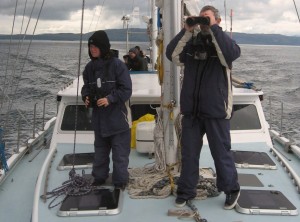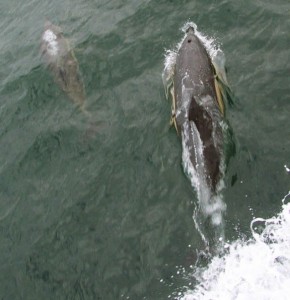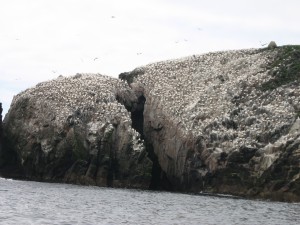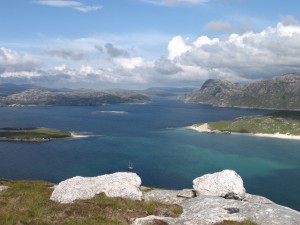I love animals and decided to devote the better part of my summer vacation volunteering with animals, which was how I found myself on a marine conservation voluntourism holiday off the west coast of Scotland through the Hebridean Whale and Dolphin Trust. Its website promised that volunteers would conduct cetacean studies using scientific methods off of a yacht. It sounded good to me so I signed up immediately.

Conduct cetacean studies we did – 8 – 10 hours a day! There were five volunteers on board ranging in age from 21 to 56. We were paired off each day, one of us with a crew member and given rotational duties that changed every hour.
The favorite volunteer duty was conducting cetacean observations where volunteers stood at the front of the boat to watch for whales, dolphins, sea lions or sharks. When the weather was stormy, volunteers were strapped into the boat with a harness to avoid being thrown overboard, which could have easily happened during high seas. Cetacean sighting duty could be really exciting, as was the day when we found 30 basking sharks in an unexpected area, or really boring as was the day when the only cetacean we spotted was a lone minke whale after 10 hours of observations.

After cetacean observation, volunteers moved to the next set of duties. One volunteer would spend 30 minutes recording cetacean sightings,including the species, location and behavior called out by the volunteers on cetacean sightings duty. This usually sounded something like “minke whale, 40°, feeding” or “dolphin, exact species unknown, 270°, swimming.” These sightings always excited the marine scientist on board, who was always hoping for a rare species. We were fortunate to get one of these on our trip with a small pod of Risso dolphins, including two young calves.
The other volunteer would spend 30 minutes doing the second favorite duty which was bird watching. The volunteer would watch for birds, identify the species and record it. The most abundant type of bird was the gannet, a white and black seabird with a pale yellow head. Bird watching was never dull since gannets were everywhere, and if in large groups sometimes hard to count on a moving boat. My personal favorite, and much less abundant was the puffin. Another black and white bird, but with a large orange beak. After 30 minutes the two volunteers would switch duties, until the hour was done and it was time to move to the next set of volunteer duties.

Next, one volunteer would get a much needed break for 30 minutes, or as was more likely the case, would end up making tea for everyone. Our captain was English and he liked his tea – 8 cups a day on average! The other volunteer would be relegated to the least interesting of the volunteering tasks, staring at a computer below deck to see if the underwater microphone was picking up any noise. Usually it wasn’t, so it was just a long 30 minutes of staring at one single line across the computer screen.
Occasionally when it did pick up something, the volunteer would notify the cetacean sighting volunteers and everyone above board would be on full alert.
Then the whole rotation started over again, stopping only for a quick lunch prepared by one of the crew members and continuing on until dinner time, which was also prepared by a rotating schedule of volunteers and crew, followed by washing dishes which was done by another pair of volunteers. Despite the small kitchen, and lack of cookbooks on board, meals were simple, but surprisingly quite good.

The marine conservation voluntourism holiday was much longer hours than I had anticipated and although a yacht sounded luxurious, our vessel, was anything but. It was a working boat which meant two volunteers per tiny cabin and six people sharing, and occasionally cleaning, one even smaller bathroom. Living on a yacht does come with a price though, even if it isn’t luxurious. Trips range from 7 and 10 days and cost between£900 – £1,200. It includes all food, accommodation and funds the research projects of the Hebridean Whale and Dolphin Trust. I personally felt it was money well spent both for the experience and for the research projects. It was much more rewarding than simply writing a check.
 Despite the long hours, sometimes boring volunteer duties, and cramped living conditions for ten days, I would do it again. I felt energized and a deeper connection with nature. I learned so much from the marine scientist on board and asked her endless questions. Needless to say the wildlife was the highlight of the trip – we saw an impressive number of minke whales, dolphins, basking sharks, the odd sea lion and thousands of sea birds. I also met some fantastic people and had enthusiastic discussions about animals that went on for hours. In our downtime, which there was very little of, I also discovered island hopping, which turned out to be of my favorite parts of the entire trip. The Hebrides comprises about 500 islands, 100 of them of which are uninhabited. Our captain would seek out islands he hadn’t been to before with the goal of reaching all 100 uninhabited islands. I have never been anywhere so remote in my life. I loved the peacefulness of it but even more loved that there are still places on this earth where humans don’t live.
Despite the long hours, sometimes boring volunteer duties, and cramped living conditions for ten days, I would do it again. I felt energized and a deeper connection with nature. I learned so much from the marine scientist on board and asked her endless questions. Needless to say the wildlife was the highlight of the trip – we saw an impressive number of minke whales, dolphins, basking sharks, the odd sea lion and thousands of sea birds. I also met some fantastic people and had enthusiastic discussions about animals that went on for hours. In our downtime, which there was very little of, I also discovered island hopping, which turned out to be of my favorite parts of the entire trip. The Hebrides comprises about 500 islands, 100 of them of which are uninhabited. Our captain would seek out islands he hadn’t been to before with the goal of reaching all 100 uninhabited islands. I have never been anywhere so remote in my life. I loved the peacefulness of it but even more loved that there are still places on this earth where humans don’t live.

